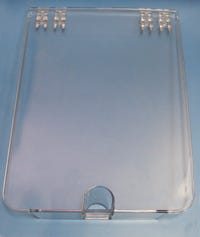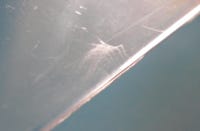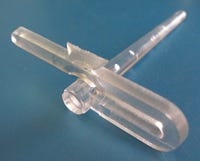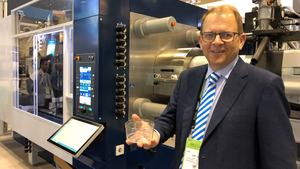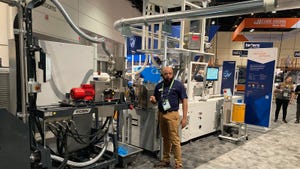The Troubleshooter, Part 106: Gates that cause cosmetic defects
Blush and splay plague an appearance part. I try to write articles that will be of interest to the most readers. Lately, I have been getting many requests on how to eliminate gate problems. My subject part for this month is an appliance cover or possibly a pet door. The material appeared to be polycarbonate and the part was gated at the bottom. It was running in a single-cavity mold and was fed through a wide edge gate fed by a cold sprue. The complaint was splay and blush.
October 29, 2008
Blush and splay plague an appearance part.
I try to write articles that will be of interest to the most readers. Lately, I have been getting many requests on how to eliminate gate problems.
My subject part for this month is an appliance cover or possibly a pet door. The material appeared to be polycarbonate and the part was gated at the bottom. It was running in a single-cavity mold and was fed through a wide edge gate fed by a cold sprue. The complaint was splay and blush.
|
Part thickness varied from 0.115 inch at the gate to 0.150 inch near the middle of the part. This told me we had a mold that needed more support or was being overpacked during injection. This condition would be addressed after the injection pressures and speeds were worked out following mold optimization.
The material appeared to be moisture-free without discoloration. This pretty much took material out of the way as far as my troubleshooting went. It didn’t mean the molecular weight or melt flow conditions of the PC were off the hook; it just meant the material was well dried and not at a temperature that was too high or for an excessive amount of time. It also told me the residence time of the material in the barrel didn’t exceed 3 minutes at a high barrel temperature or more than 5 minutes for low temperatures. I interpreted this to mean the melt temperature (not setpoint) of the PC did not exceed 530°F if it were an easy-flow grade and no more than 560°F if it were a stiff-flow grade.
The runner had a trapezoidal design—never good for an amorphous material like PC—and the gate came off the side, instead of the middle, of the runner, which created high shear. For molds running PC, I recommend a full-round runner, either curved like this one or straight, with a 0.250-inch diameter. I would feed the 0.250-inch main runner with a 0.300- or even 0.312-inch O-diameter cold sprue bushing instead of the existing 0.200 inch. The molding machine nozzle should be a full-taper design with the orifice sized around 0.290 inch.
On the gate location, it needed to exit the middle of the runner by going through an abrupt transition as it passed from the sprue to the part cavity. The original tapered gate design, which is better for olefin materials, would need to change to a PC design, where the gate depth equals 90% of the wall being gated into, the width equals twice the depth, and the land length is one-half the depth but does not exceed 0.030 inch.
Finally, some processing adjustments would generate good-looking parts: fast injection speeds, injection pressures around 1000 psi, and hold pressures in the 800-psi range. The barrel heat would need to be adjusted to achieve these settings.
I called the molder with my suggestions, got his assurance he would let me know how the changes worked out, and received a job offer (which I turned down because I like working for myself).
The Troubleshooter’s notebook
Part/material: PC appliance cover/pet door.
Tool: Single-cavity cold runner.
Symptoms/problem: Blush and splay around the gate.
Solution: Change trapezoidal runner to full-round design; remove restrictions from the gate area; increase size of sprue; change to a full-taper nozzle with a larger orifice; adjust processing conditions.
About the Author(s)
You May Also Like

